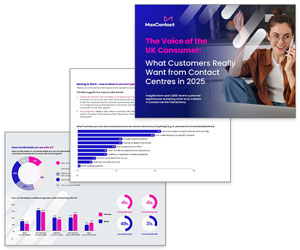Striving for an all-round better customer service experience?
Our consultants panel – featuring Kim Ellis, Shep Hyken, Peter Massey, and more – share their thoughts on how to measure and improve customer happiness.
1. Throw Some Newer Metrics Into the Mix – Including “Time Well Spent”

When did you last review your mix of metrics to see what’s new out there?
Above and beyond your traditional NPS and CSAT metrics, there are now some newer metrics that can really help your contact centre to better understand and improve customer happiness, including:
The ‘Time Well Spent’ Metric
Created by Stone Mantel, the ‘Time Well Spent’ metric simply asks: “Do you consider your experience with us to be time well spent?”
This captures valuable insight on whether you got the job done for your customer when they engaged with you, and if they considered the experience worth the time they spent – or wasted.
The ‘Time to Happiness’ Metric
The ‘Time to Happiness’ metric measures customer happiness from the time they are unhappy (as best you know) to the point they get in contact with you and then feel satisfied. Speed is everything here.
Contributed by: Shep Hyken, Chief Amazement Officer (CAO) at Shepard Presentations LLC
2. Incentivize Customers to Give Video Feedback for Qualitative Insights

Have you ever considered a focus group panel? Or giving your customers the opportunity to record video feedback?
These initiatives could let your customers give you their feedback in a new way, so rather than just filling in a form or using a chatbot, you could get more qualitative feedback.
To increase the response rates, you could run a monthly competition per feedback channel, like a feedback raffle where the randomly selected customers receive a gift or a discount from your products.
For example, ‘Tell us how we did by recording a short video, and be included in this month’s prize draw’. Yes, there are costs involved in this, but the potential rewards could be enormous.
3. …And Then ‘Show and Tell’ What You’ve Changed
And what do you do once you’ve gathered this new intel? If you’ve gathered feedback from videos, you could ask permission to use excerpts of the videos in any upcoming marketing campaigns.
If you have negative feedback, you could use it as an opportunity to respond via video in a campaign and show what you’ve changed or how a process is being done differently.
This type of feedback will give you more of a direct line to your customers.
Contributed by: Kim Ellis, Chief Learning Architect at Go Ginger Learning Solutions
4. Ask the Frontline What THEY Think Will Make a Difference

Go to your agents first!
Go to your agents daily and have conversations. Ask how they think the customers are doing.
Ask about pain points causing customer contention. Take this data back and act. Then, go back to your employees and get new actionable points.
Also make sure you back your agent’s judgement call. When they make a decision, good or bad, SUPPORT that decision!
If changes need making, changes can be made, and you will both learn together, but support that decision in public and make corrections in private.
Nothing irritates agents more than a team lead, manager, or supervisor who doesn’t have common courtesy, is ill-mannered, and only barks orders.
Contributed by: Dr M. Dave Salisbury, COO at D&C Consulting LLC
5. Train Your Agents in ‘Forensic Listening’

Want a novel way to gauge your customers’ happiness? Train your agents to move beyond simple listening by adopting ‘forensic listening’.
This approach involves not only listening to what customers say, but also deciphering what’s left unsaid. By analysing interactions for emotion and subtle cues, your agents can gain deeper insights into your customers’ true level of happiness.
Contributed by: Matt Lyles, Keynote Speaker, Brand Consultant and Podcast Host at Matt Lyles & Co LLC
6. Stop and Think About Why Customers Might NOT Be Filling in Your Surveys

I was once responsible for organizing a detailed ‘Voice of the Customer’ survey with our top ten clients. One refused to do it and that told me everything I needed to know – why wouldn’t they want to talk about their satisfaction?
Of all the measures available, ‘effort’ eats ‘satisfaction’ for breakfast, so focus everything on a frictionless customer experience.
Nothing is more illuminating about the alignment or mismatch of the service you think you’re providing vs the customer’s perception of the same.
Contributed by: Beverley Mullard (Previously ‘Hughes’), a respected voice within the contact centre community
7. Focus Your Efforts on Creating ‘Happier’ Customers – Not ‘The Happiest’

Happiness is a complex set of feelings that even the subject can’t always explain. It is a subjective reaction to actions you might take to improve some factors such as design, offering or experience.
You can’t improve happiness per se. Only the individual who experiences what you offer feels more OR less happy.
Don’t overthink or over-analyse happiness is my advice. Simplify and focus: ask the subject to tell you what they think would make them happier.
Measuring happiness has been attempted in many questionnaires and indexes. Subjectivity brings high volatility.
My advice is to replace the absolute or comparative measurement of most happy with the personal question of ‘what would make you more happy?’.
Apply it to colleagues as well as customers and it’s very useful in all sorts of conversations. As long as you listen to the answers, of course!
Contributed by: Peter Massey, MD & co-founder at Budd UK Ltd
8. Set a Vision for Meeting Customers’ Needs

There are no shortcuts to happy customers. Put in the work day in and day out while continuously focusing on your vision and you will have more happy customers.
When it comes to customer happiness, I love a good customer shout-out as much as the next person. But we must always remember that this is just one customer – a one-off of sorts.
For those of us working in the contact centre, we can have a much greater impact on customer happiness by running a good operation.
Here are just some of the things we can do to have a major impact:
- Understand the needs of customers AND set a vision for meeting those.
- Advocate for customer-centric policies.
- Create a quality system that promotes customer-centric interactions.
- Regularly evaluate and coach agents.
Contributed by: Jeremy Watkin, Director of Customer Experience and Support at NumberBarn
9. Remember Not All Scenarios Require ‘Amazing’ CX

It’s very easy to think that customer happiness is all about providing an ‘amazing’ customer experience (CX).
True, this can be a differentiator, but not all scenarios require it. Sometimes doing the basics reliably well is what the customer wants.
Think of budget airlines. Customers are attracted by low prices and convenient regional schedules, accepting a ‘no frills’ service.
When I started my first consulting business and was paying for my business flights rather than it being a corporate expense, my mindset changed from valuing the perks of business travel – like the loyalty scheme – to prioritizing how promptly the airline got me to my destination.
I became a ‘fan’ of EasyJet because it was cheaper than BA and did one thing really well. All the time their operational reliability was good, I was happy.
When nine out of ten flights are on time, then you’ll excuse the occasional weather-related problem when it occurs.
Contributed by: Paul Weald, The Contact Centre Innovator
10. Tune Into Tone, Words, and Silences to Better Understand Your Customers

Customer happiness is fundamental to business success, but it can’t be a single measure. It needs to be asked in the context of the overall view of how a customer feels about your business and their interactions with it.
Consequently, the fast declining and basically worthless NPS measurement won’t cut it, and neither will touchpoint surveys (“How would you rate the service that Joe/Jane provided today?”).
Both might keep the CEO happy, but they are unlikely to be a true and reliable measure of overall customer happiness.
As we can generally sense emotions in others by what they say and how they say it, then speech and voice analytics (which track both of those) are some of the best measures of customer (and colleague) happiness. They will provide the clues that can improve overall CX.
For example, using voice analytics to detect positive or negative sentiment based on customer and colleague tone, words, and silences.
It can also flag any inflammatory words, phrases or jargon that are causing the customer to be unhappy. This insight can be used in advisor coaching sessions.
Contributed by: Gerry Brown, Chief Customer Rescue Officer at The Customer Lifeguard
11. Invest Time in Understanding the ‘Total Experience’

Today, understanding customer happiness transcends traditional metrics. It’s not just about the speed of answering a call or the non-verbal ‘smile’.
It’s about the entire Total Experience, covering customer and employee experiences, user experience, and more.
Measuring this new kind of customer happiness goes beyond survey scores. It’s about actively listening – REALLY listening – to customer feedback across all platforms. Do they connect with our brand values? Do they appreciate our stance on societal issues?
Improving customer happiness, particularly where weaknesses are identified, involves regular training, feedback loops, employee engagement, and action on insights.
Contributed by: Rob Clarke, Director and Co-Founder of Elev-8 Performance
12. Equip Agents With the Tools to Resolve Issues Promptly

Equip your agents with tools, knowledge, and autonomy to resolve issues promptly. Invest in training programmes focusing on empathy, problem-solving, and effective communication.
It can also make a difference to implement real-time feedback mechanisms such as chatbots, instant surveys, or post-interaction feedback requests.
This helps contact centres capture immediate reactions, offering valuable insights into customer experiences.
Not only that but be sure to personalize experiences with tailored interactions based on customer history and preferences. Then use data to provide personalized solutions and proactive support, making customers feel valued.
Contributed by: Dan Pratt, Customer Experience and Business Consultant, Founder & Director DAP Consultancy
13. Use Gamification to Keep Agents Focused on Delivering Great CX

One way to help drive customer happiness is to embrace gamification tools for your agents.
A lot of telephony systems include ways to incentivize and reward team members with points and rewards to redeem in virtual shops to create a culture of positive reward for positive behaviour.
Beyond this, it can also make a difference to show agents their value with positive conversations. Little and often can be better motivators then structured monthly 1-2-1s too!
Create time to recognize your teams’ positive contributions regularly with ad hoc coaching and feedback sessions – it’s the conversation that matters!
Contributed by: Garry Gormley, Founder, CEO – FAB Outsourced Solutions
14. Make a Habit of Identifying Pain Points and Recurring Issues

Improving customer happiness involves a multifaceted approach. Analyse collected data to identify pain points or recurring issues voiced by customers.
Then these insights can be used to inform products, services, or operational procedures, addressing concerns proactively.
In addition, AI-powered chatbots or virtual assistants can offer instant, personalized support, tailoring communication strategies based on customer preferences aids – to help build stronger connections and cater to individual needs.
Regularly reassessing customer feedback and adapting strategies accordingly also supports the measurement of customer happiness and provides actionable insights to help you enhance satisfaction levels.
Contributed by: Giuseppe Venturini at adooa
15. Don’t Forget the Fundamental Need for Trust and Consistency

When looking to improve customer happiness, get the basics right first. After all, consistency builds trust, trust builds relationships, relationships build loyalty, and loyalty builds your business.
It can also make a difference to personalize your interaction to emotionally bond your customers to you. Remember, good customer service is having a smile on your face, great customer care is having a smile on your customers’ faces.
Contributed by: Bill Quiseng, Chief Experience Officer at billquiseng.com
Looking for more information on customer emotion and how to improve your contact centre? Read these next:
- How to Target the Feelings That Drive Customer Behaviours
- Five Steps to Map Emotions Onto the Customer Journey
- 15 Tips for Building Emotional Intelligence in Customer Service
If you want more great insights and advice from our panel of experts, read these articles next:
- CRM Today: How the Best Contact Centres Are Using CRM
- 15 Surprises for Boosting Agent Morale
- The Latest Trends in CX Self-Service
- 29 Ways to Transform Your Call Centre Staff Surveys
Author: Megan Jones
Published On: 24th Jan 2024 - Last modified: 9th Jan 2025
Read more about - Customer Service Strategy, Beverley Mullard, Bill Quiseng, Customer Engagement, Customer Service, CX, Dan Pratt, Dave Salisbury, Emotion, Garry Gormley, Gerry Brown, Giuseppe Venturini, Jeremy Watkin, Kim Ellis, Matt Lyles, Paul Weald, Peter Massey, Rob Clarke, Shep Hyken, Top Story





















